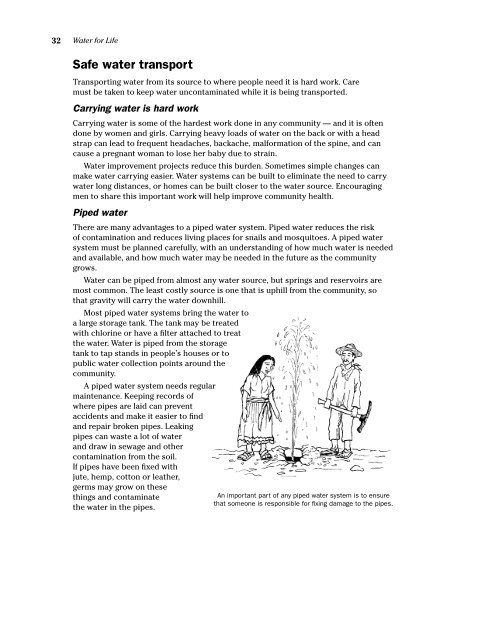Community water security - UN-Water
Community water security - UN-Water
Community water security - UN-Water
You also want an ePaper? Increase the reach of your titles
YUMPU automatically turns print PDFs into web optimized ePapers that Google loves.
32<br />
<strong>Water</strong> for Life<br />
Safe <strong>water</strong> transport<br />
Transporting <strong>water</strong> from its source to where people need it is hard work. Care<br />
must be taken to keep <strong>water</strong> uncontaminated while it is being transported.<br />
Carrying <strong>water</strong> is hard work<br />
Carrying <strong>water</strong> is some of the hardest work done in any community — and it is often<br />
done by women and girls. Carrying heavy loads of <strong>water</strong> on the back or with a head<br />
strap can lead to frequent headaches, backache, malformation of the spine, and can<br />
cause a pregnant woman to lose her baby due to strain.<br />
<strong>Water</strong> improvement projects reduce this burden. Sometimes simple changes can<br />
make <strong>water</strong> carrying easier. <strong>Water</strong> systems can be built to eliminate the need to carry<br />
<strong>water</strong> long distances, or homes can be built closer to the <strong>water</strong> source. Encouraging<br />
men to share this important work will help improve community health.<br />
Piped <strong>water</strong><br />
There are many advantages to a piped <strong>water</strong> system. Piped <strong>water</strong> reduces the risk<br />
of contamination and reduces living places for snails and mosquitoes. A piped <strong>water</strong><br />
system must be planned carefully, with an understanding of how much <strong>water</strong> is needed<br />
and available, and how much <strong>water</strong> may be needed in the future as the community<br />
grows.<br />
<strong>Water</strong> can be piped from almost any <strong>water</strong> source, but springs and reservoirs are<br />
most common. The least costly source is one that is uphill from the community, so<br />
that gravity will carry the <strong>water</strong> downhill.<br />
Most piped <strong>water</strong> systems bring the <strong>water</strong> to<br />
a large storage tank. The tank may be treated<br />
with chlorine or have a filter attached to treat<br />
the <strong>water</strong>. <strong>Water</strong> is piped from the storage<br />
tank to tap stands in people’s houses or to<br />
public <strong>water</strong> collection points around the<br />
community.<br />
A piped <strong>water</strong> system needs regular<br />
maintenance. Keeping records of<br />
where pipes are laid can prevent<br />
accidents and make it easier to find<br />
and repair broken pipes. Leaking<br />
pipes can waste a lot of <strong>water</strong><br />
and draw in sewage and other<br />
contamination from the soil.<br />
If pipes have been fixed with<br />
jute, hemp, cotton or leather,<br />
germs may grow on these<br />
things and contaminate<br />
the <strong>water</strong> in the pipes.<br />
An important part of any piped <strong>water</strong> system is to ensure<br />
that someone is responsible for fixing damage to the pipes.
















